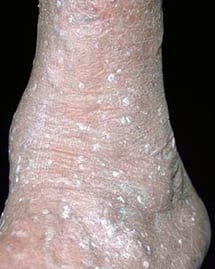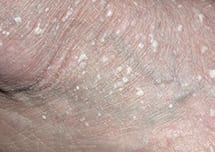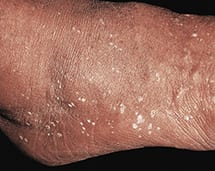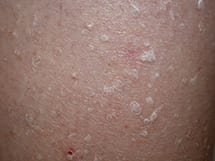Stucco Keratoses (Hyperkeratotic Seborrheic Keratoses, Keratosis Alba, Verrucous Seborrheic Keratoses)
Serving Hamilton, Stoney Creek, Grimsby and surrounding areas
Stucco Keratoses:
- Were given this name because they look like small pieces of dried stucco on the skin
- Are areas of thickened skin which usually develop on the lower legs, tops and sides of the feet and toes
- Do not appear on the soles
- Are not the same as moles
- Are not cancerous and never develop into a skin cancer
- Are usually white or grey in colour
- Are “dry” and scaly
- May be flat or raised
- Are not due to the Human Papilloma (HPV) wart virus
- Are not due to diet or sun damage
- Usually appear as the skin matures
- Are not contagious
- May get gradually larger and increase in number with time
- Do not disappear spontaneously
Treatment
Liquid Nitrogen:
- The treatment that I use most often is liquid nitrogen, which is a cold, freezing spray
- The treatments sting and the area treated may remain sore for 1 to 2 days
- The treatment may produce blisters
- This is normal
- If the blisters are painful, pop them with a sterile needle to let the fluid out
- The treated area requires no special treatment
- You may bathe normally
- A bandage is not necessary, but may be worn if desired
Surgical Removal:
- In some cases it is best to remove the stucco keratoses with a small surgical procedure
- The skin adjacent to a stucco keratosis is injected with a local anesthetic to numb the area
- The stucco keratosis is removed and the base treated with a medication or electrocautery, so that it does not bleed
- Stitches are not necessary
- The removal is not painful
- After the procedure you may bathe normally
- For two weeks after the procedure, apply a small amount of antibiotic and change the bandage daily
- After a stucco keratosis has been removed a crust or scab will form
- This will heal and leave a pink mark that will gradually fade
- After the removal, there may be a residual white mark
- There is a small chance that the stucco keratosis could grow back
- There is a very high likelihood that new stucco keratoses will develop with time
- Treatment of seborrheic keratoses is not covered by OHIP or private health insurance
- A referral from a doctor is necessary to make your first appointment
Stucco Keratoses – Foot and Ankle
Stucco Keratoses – Ankle
Stucco Keratoses – Sides of Foot
Stucco Keratoses
What if you are interested to learn more?
If you would like to learn more please phone the aesthetic centre directly at (905) 549-7873 to book a free consultation with one of our knowledgeable technicians or




